fuse TOYOTA CAMRY 2011 XV50 / 9.G Owners Manual
[x] Cancel search | Manufacturer: TOYOTA, Model Year: 2011, Model line: CAMRY, Model: TOYOTA CAMRY 2011 XV50 / 9.GPages: 554, PDF Size: 9.69 MB
Page 5 of 554

1
2
3
4
5
6
7
5
4-3. Do-it-yourself maintenance
Do-it-yourself service precautions ....................... 365
Hood ................................... 368
Positioning a floor jack ........ 369
Engine compartment ........... 371
Tires .................................... 387
Tire inflation pressure ......... 397
Wheels ................................ 401
Air conditioning filter............ 403
Key battery .......................... 406
Checking and replacing fuses ................................. 410
Light bulbs........................... 423
5-1. Essential information Emergency flashers ............ 428
If your vehicle needs to be towed ........................... 429
If you think something is wrong ............................ 432
Fuel pump shut off system .............................. 433
Event data recorder ............ 434 5-2. Steps to take in an
emergency
If a warning light turns on or a warning buzzer
sounds... .......................... 436
If a warning message is displayed .......................... 448
If you have a flat tire ........... 458
If the engine will not start.... 469
If the shift lever cannot be shifted from P .............. 471
If you lose your keys........... 472
If the electronic key does not operate properly ......... 473
If the battery is discharged........................ 475
If your vehicle overheats .... 479
If the vehicle becomes stuck ................................. 482
If your vehicle has to be stopped in an
emergency ....................... 484
5When trouble arises
Page 289 of 554
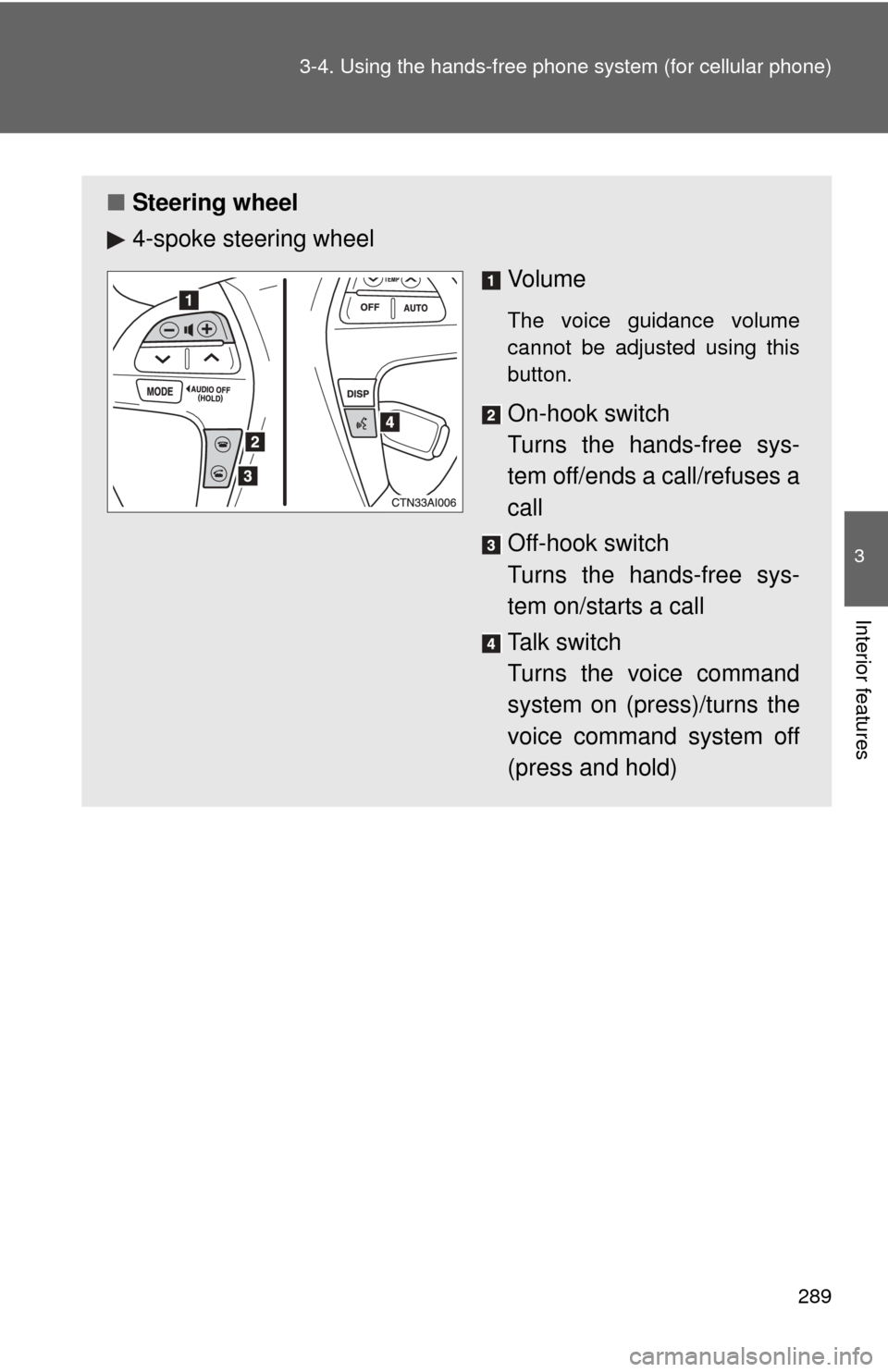
289
3-4. Using the hand
s-free phone system (for cellular phone)
3
Interior features
■Steering wheel
4-spoke steering wheel
Vo l u m e
The voice guidance volume
cannot be adjusted using this
button.
On-hook switch
Turns the hands-free sys-
tem off/ends a call/refuses a
call
Off-hook switch
Turns the hands-free sys-
tem on/starts a call
Talk switch
Turns the voice command
system on (press)/turns the
voice command system off
(press and hold)
Page 290 of 554
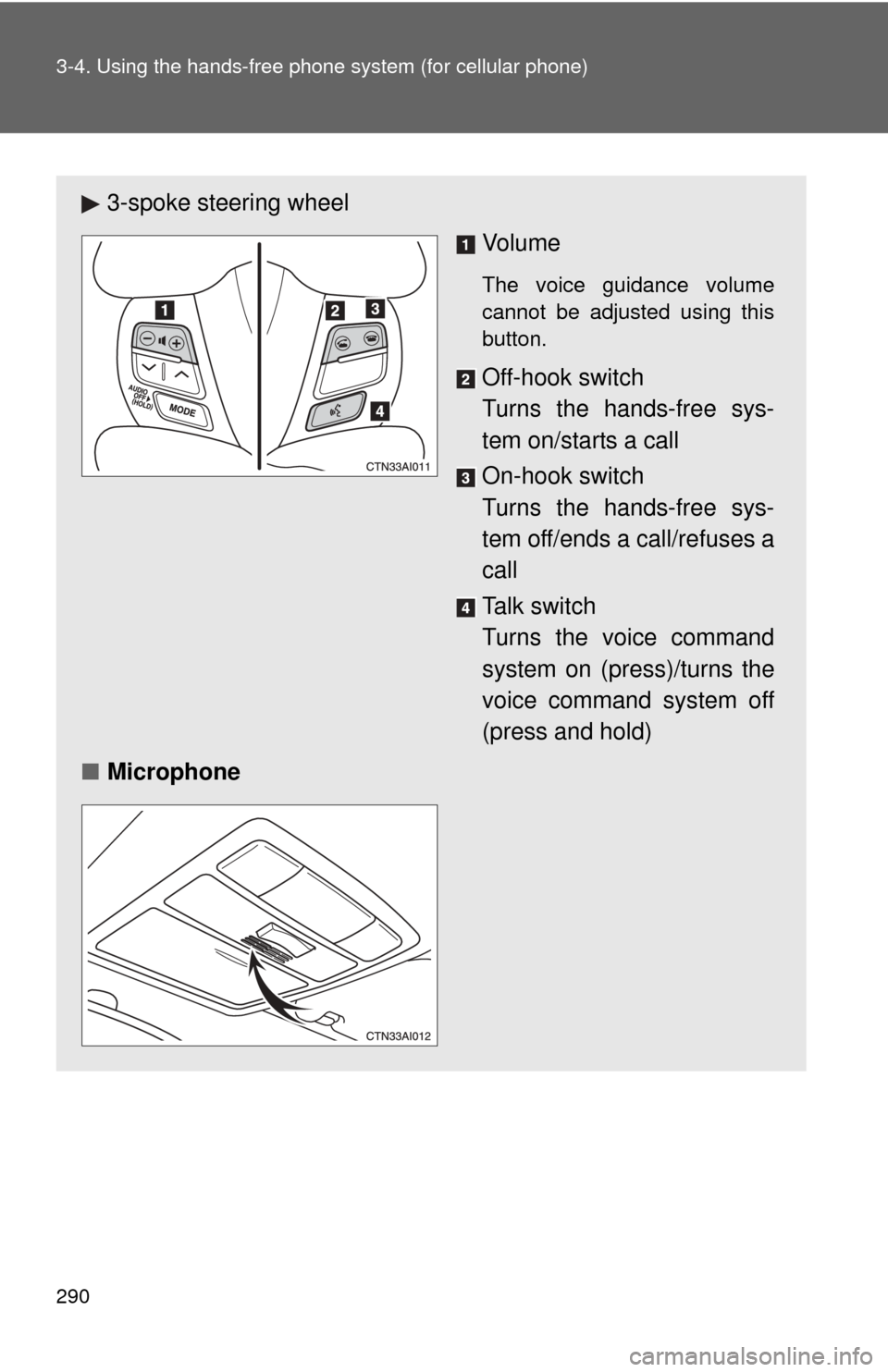
290 3-4. Using the hands-free phone system (for cellular phone)
3-spoke steering wheel
Vo l u m e
The voice guidance volume
cannot be adjusted using this
button.
Off-hook switch
Turns the hands-free sys-
tem on/starts a call
On-hook switch
Turns the hands-free sys-
tem off/ends a call/refuses a
call
Talk switch
Turns the voice command
system on (press)/turns the
voice command system off
(press and hold)
■ Microphone
Page 334 of 554

334 3-7. Other interior features
■The power outlet can be used when
Vehicles with smart key system
The “ENGINE START STOP” switch is in ACCESSORY or IGNITION ON
mode.
Vehicles without smart key system
The engine switch is in the “ACC” or “ON” position.
■ Cable pass-through
Connected cables can be passed through the hole in the auxiliary box to the
front passenger’s side of the auxiliary box. ( P. 328)
NOTICE
■To avoid damaging the power outlet
Close the power outlet lid when the power outlet is not in use.
Foreign objects or liquids that enter the power outlet may cause a short cir-
cuit.
■ To prevent the fuse from being blown
Do not use an accessory that uses more than 12 V 10 A.
■ To prevent the battery from being discharged
Do not use the power outlet longer than necessary when the engine is not\
running.
Page 353 of 554
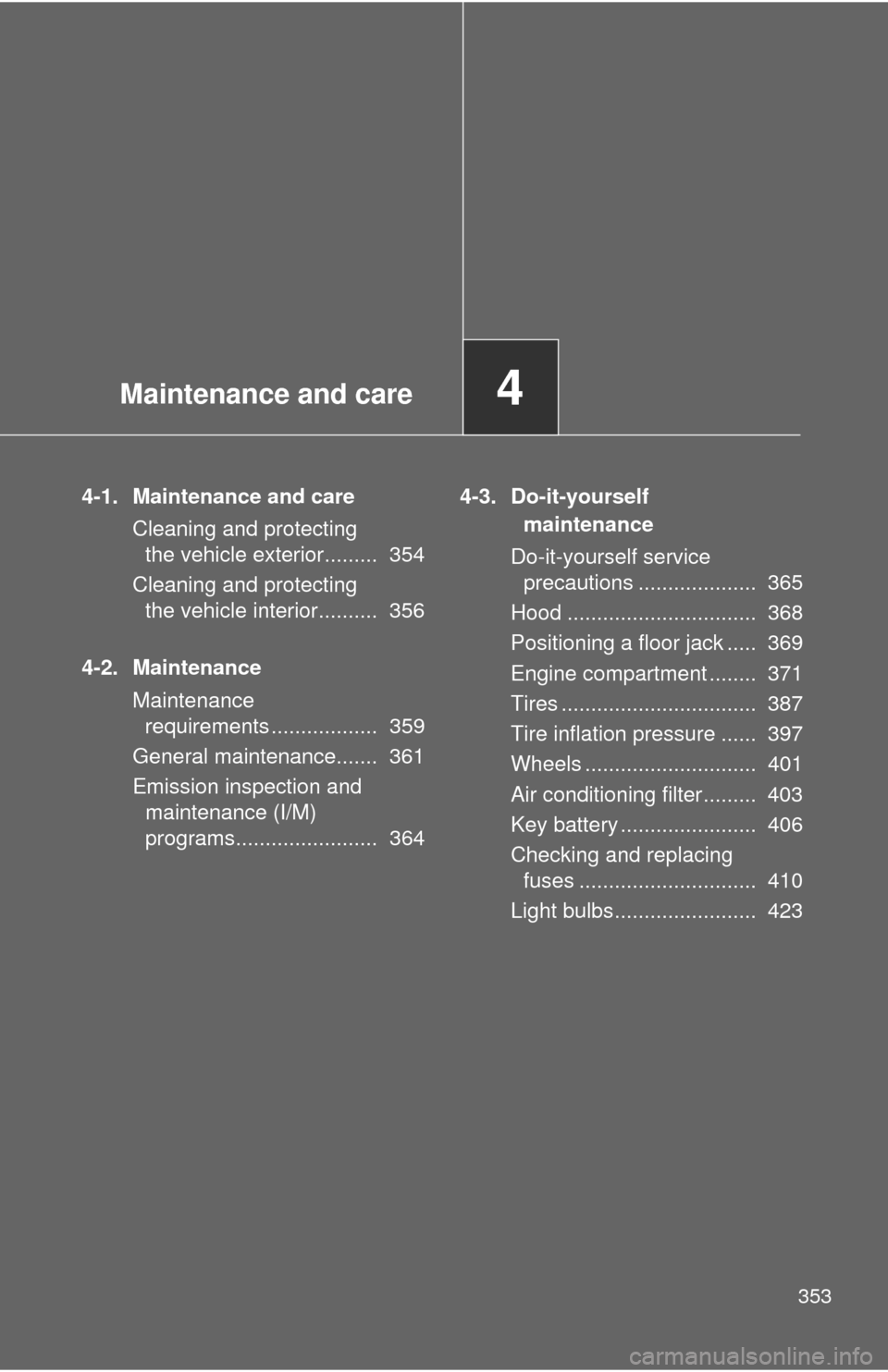
Maintenance and care4
353
4-1. Maintenance and careCleaning and protecting the vehicle exterior......... 354
Cleaning and protecting the vehicle interior.......... 356
4-2. Maintenance Maintenance requirements .................. 359
General maintenance....... 361
Emission inspection and maintenance (I/M)
programs........................ 364 4-3. Do-it-yourself
maintenance
Do-it-yourself service precautions .................... 365
Hood ................................ 368
Positioning a floor jack ..... 369
Engine compartment ........ 371
Tires ................................. 387
Tire inflation pressure ...... 397
Wheels ............................. 401
Air conditioning filter......... 403
Key battery ....................... 406
Checking and replacing fuses .............................. 410
Light bulbs........................ 423
Page 367 of 554
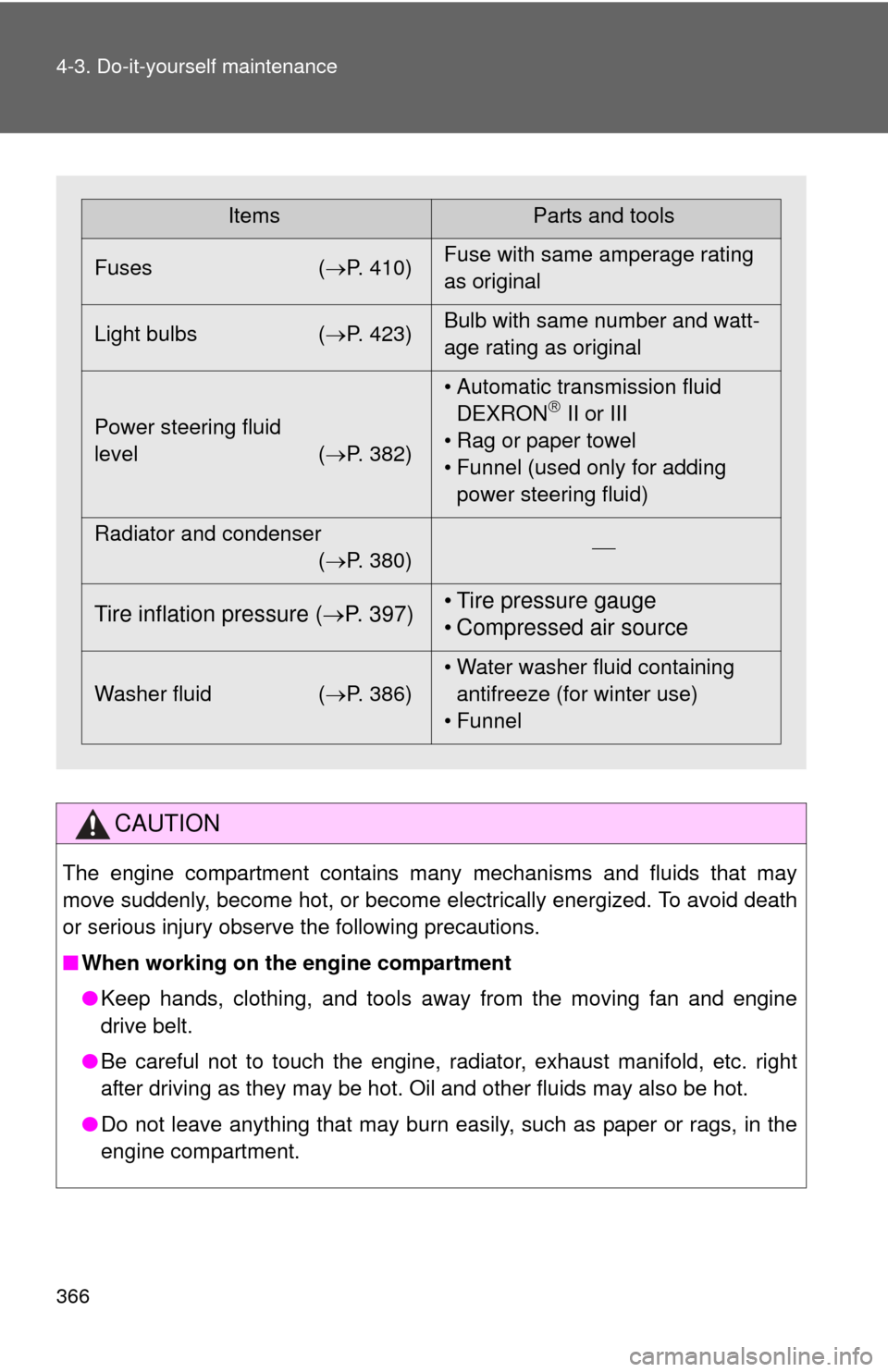
366 4-3. Do-it-yourself maintenance
CAUTION
The engine compartment contains many mechanisms and fluids that may
move suddenly, become hot, or become electrically energized. To avoid death
or serious injury observe the following precautions.
■When working on the engine compartment
●Keep hands, clothing, and tools away from the moving fan and engine
drive belt.
● Be careful not to touch the engine, radiator, exhaust manifold, etc. right
after driving as they may be hot. Oil and other fluids may also be hot.
● Do not leave anything that may burn easily, such as paper or rags, in the
engine compartment.
ItemsParts and tools
Fuses ( P. 410)Fuse with same amperage rating
as original
Light bulbs ( P. 423)Bulb with same number and watt-
age rating as original
Power steering fluid
level ( P. 382)• Automatic transmission fluid
DEXRON
II or III
• Rag or paper towel
• Funnel (used only for adding power steering fluid)
Radiator and condenser (P. 380)
Tire inflation pressure (
P. 397) • Tire pressure gauge
• Compressed air source
Washer fluid
(P. 386) • Water washer fluid containing
antifreeze (for winter use)
• Funnel
Page 372 of 554
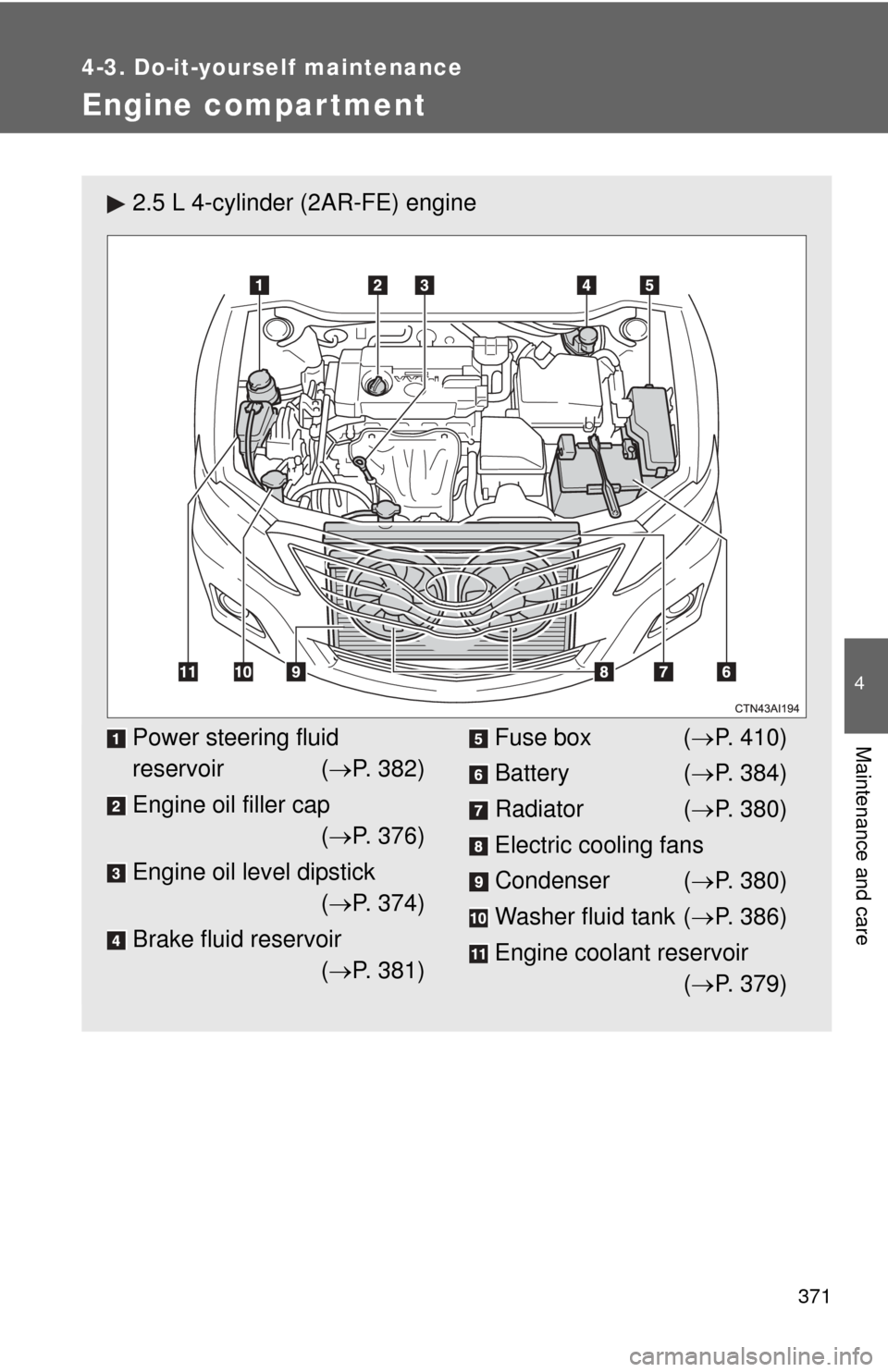
371
4-3. Do-it-yourself maintenance
4
Maintenance and care
Engine compar tment
2.5 L 4-cylinder (2AR-FE) engine
Power steering fluid
reservoir (P. 382)
Engine oil filler cap ( P. 376)
Engine oil level dipstick ( P. 374)
Brake fluid reservoir ( P. 381)Fuse box ( P. 410)
Battery ( P. 384)
Radiator ( P. 380)
Electric cooling fans
Condenser ( P. 380)
Washer fluid tank ( P. 386)
Engine coolant reservoir ( P. 379)
Page 373 of 554
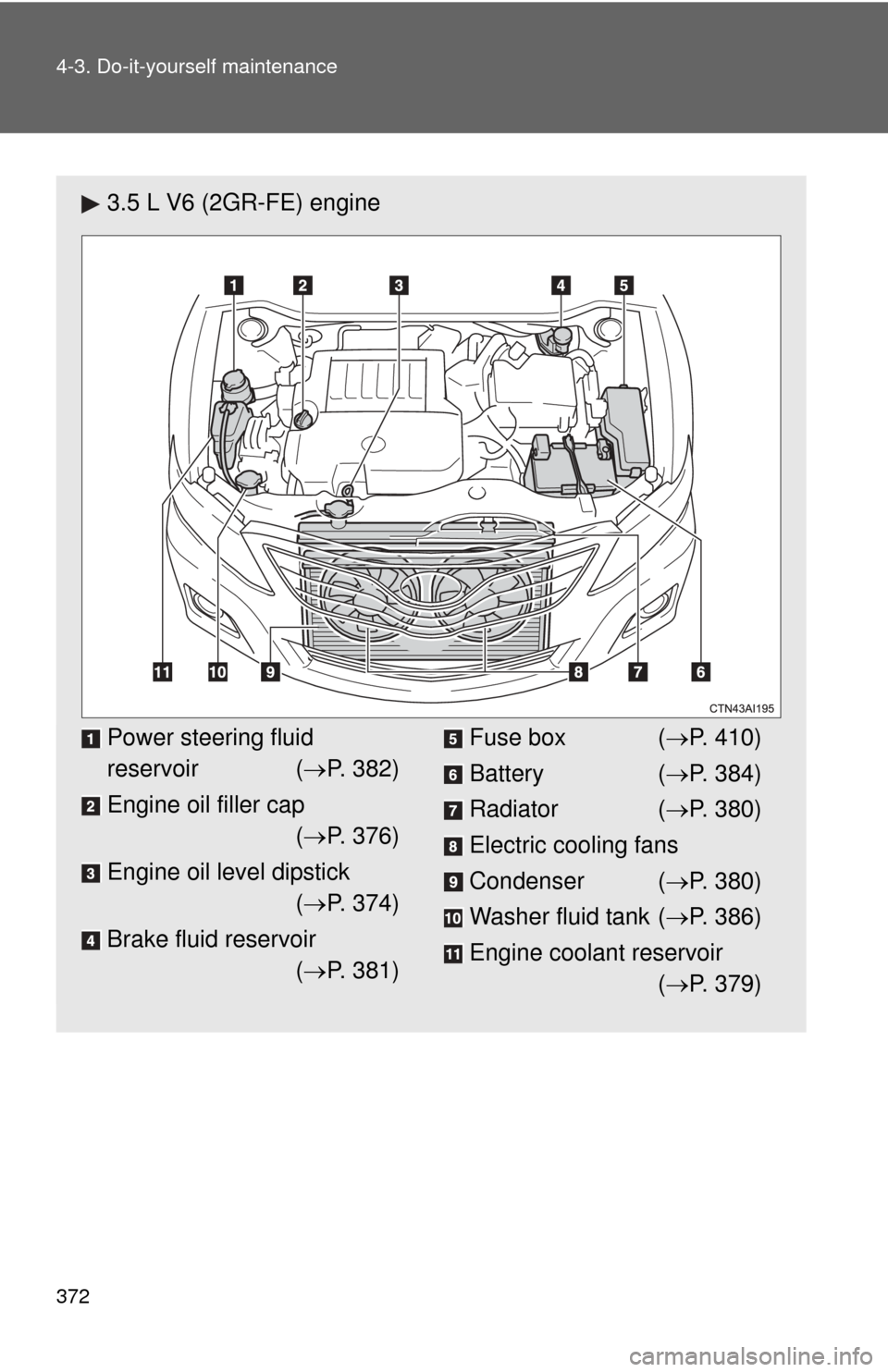
372 4-3. Do-it-yourself maintenance
3.5 L V6 (2GR-FE) engine
Power steering fluid
reservoir (P. 382)
Engine oil filler cap ( P. 376)
Engine oil level dipstick ( P. 374)
Brake fluid reservoir ( P. 381)Fuse box ( P. 410)
Battery ( P. 384)
Radiator ( P. 380)
Electric cooling fans
Condenser ( P. 380)
Washer fluid tank ( P. 386)
Engine coolant reservoir ( P. 379)
Page 411 of 554
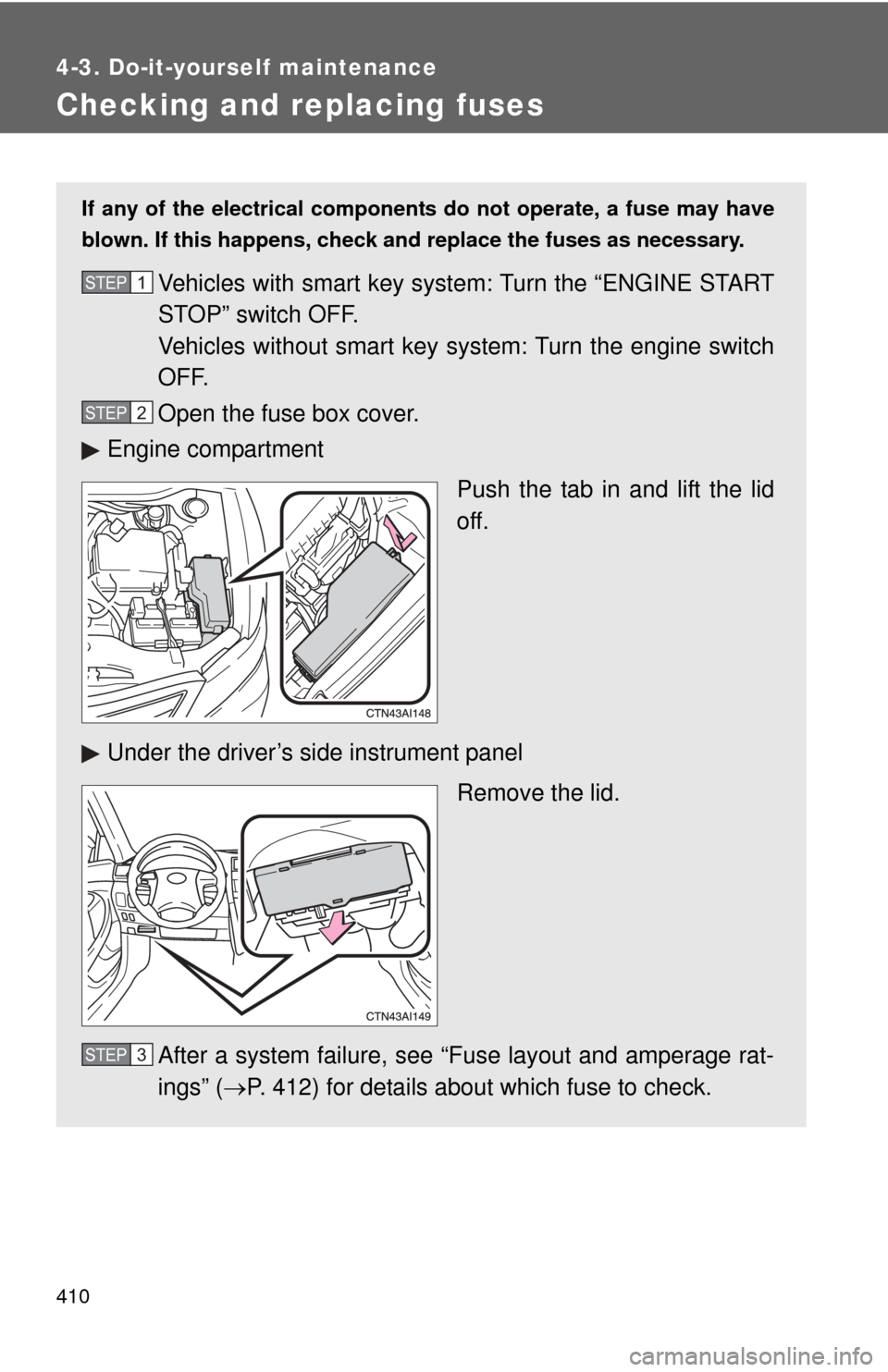
410
4-3. Do-it-yourself maintenance
Checking and replacing fuses
If any of the electrical components do not operate, a fuse may have
blown. If this happens, check and replace the fuses as necessary.
Vehicles with smart key system: Turn the “ENGINE START
STOP” switch OFF.
Vehicles without smart key system: Turn the engine switch
OFF.
Open the fuse box cover.
Engine compartment
Push the tab in and lift the lid
off.
Under the driver’s side instrument panel Remove the lid.
After a system failure, see “Fuse layout and amperage rat-
ings” ( P. 412) for details about which fuse to check.STEP1
STEP2
STEP3
Page 412 of 554

411
4-3. Do-it-yourself maintenance
4
Maintenance and care
Take out the pullout tool.
Only type A fuse can be
removed using the pullout tool.
Check if the fuse has blown.
Ty p e A
Normal fuse
Blown fuse
Replace it with one of an
appropriate amperage rating.
The amperage rating can be
found on the fuse box lid.
Ty p e BNormal fuse
Blown fuse
Replace it with one of an
appropriate amperage rating.
The amperage rating can be
found on the fuse box lid.
STEP4
STEP5